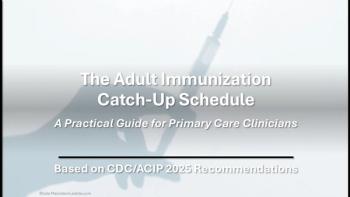
Antibiotic Drug Resistance: Which Bugs, Which Drugs?
The emergence of antimicrobial resistance has increasingly impeded the management of a number of clinically important infections.
The emergence of antimicrobial resistance has increasingly impeded the management of a number of clinically important infections. Noteworthy examples include infections caused by penicillin-resistant Streptococcus pneumoniae, methicillin-resistant Staphylococcus aureus (MRSA) (Figure), antibiotic-resistant Pseudomonas aeruginosa, vancomycin-resistant enterococci (VRE), and fluoroquinolone-resistant Clostridium difficile.
Infections caused by MRSA, for instance, are occurring more frequently-in the community as well as in the hospital setting. Compared with infections caused by methicillin-susceptible S aureus (MSSA), those caused by MRSA are associated with longer hospital stays, higher mortality, and increased costs.1-3 Similar adverse consequences have been observed in patients with other antimi-crobial-resistant infections. Presented here are highlights of recent studies on MRSA and other antibiotic-resistant pathogens.
CA-MRSA SKIN INFECTIONS
According to a recent study, community-associated MRSA (CA-MRSA) infection has emerged among the urban poor in Chicago.4 It appears to have occurred in addition to (rather than instead of) MSSA infection. Hota and associates4 analyzed the risk factors for CA-MRSA skin and soft tissue infections at a public hospital in Chicago. Of the 73 strains tested, 79% were type USA300 on pulsed-field gel electrophoresis. The incidence of CA-MRSA skin and soft tissue infections increased from 24 cases per 100,000 persons in 2000 to 164.2 cases per 100,000 in 2005 (relative risk, 6.84). The incidence of MSSA infections was stable during this period.
The risk factors for CA-MRSA infections included recent incarceration, African American ethnicity, and residence at certain public housing complexes. Overcrowding was not a risk factor. Older age was inversely associated with the risk of MRSA infections. The authors note that CA-MRSA infection may become endemic as it disseminates within communities.
CA-MRSA PNEUMONIA
A report from the CDC emphasizes the importance of being on the alert for CA-MRSA pneumonia, particularly in patients with influenza.5 This type of pneumonia often occurs in young, previously healthy persons, and it can be rapidly fatal.
In December 2006 and January 2007, 10 cases of severe CA-MRSA pneumonia occurred in Louisiana and Georgia. These cases involved previously healthy persons, 5 of whom were younger than 15 years. MRSA was documented by specimens (usually sputum or blood) that were obtained from the patients less than 48 hours after hospitalization or arrival at the emergency department (ED). Its association with influenza was established by either laboratory testing or by a diagnosis of influenza-like illness, which was defined as a temperature of 37.8°C (100°F) or higher, with cough or pharyngitis, in the absence of a known cause of these symptoms other than influenza. Four of the patients had a documented history of MRSA skin or soft tissue infection or close contact with someone who had such an infection before the onset of pneumonia. Respiratory symptoms began a median of 3 days before recovery from MRSA infection, and 4 of the 6 patients who died did so within 4 days of the onset of respiratory symptoms. This suggests that influenza and MRSA infection probably occurred concomitantly.
MRSA BACTEREMIA
Shurland and coworkers6 retrospectively studied 438 adults who had S aureus infection complicated by bacteremia. MRSA was documented in 193 (44%) of the patients. One hundred fourteen (26%) of the patients died of S aureus-related infection within 90 days of diagnosis. The risk of death was higher for those with MRSA infection than for those with MSSA infection (relative risk, 1.7).
Patients with MRSA infections were older, had more comorbidities, and were more likely to have severe sepsis than those with MSSA infections. After adjusting for age, comorbidities, and the presence of pneumonia, the risk of S aureus-related death was higher among patients with MRSA infections (hazard ratio, 1.8).
MUPIROCIN RESISTANCE
The intranasal administration of mupirocin has been considered as a method of preventing nosocomial MRSA infections. However, a recent study of patients in a surgical ICU has documented a high rate of mupirocin resistance among MRSA isolates.7
Jones and colleagues7 analyzed 302 MRSA isolates from nasal swabs obtained from patients in a surgical ICU in St Louis. The incidence of resistance to mupirocin was 13.2%. The incidence of high-level resistance was 8.6%. Patients colonized with mupirocin-resistant MRSA were more likely to have been admitted to the hospital in the previous year and were older, compared with patients colonized with mupirocin-susceptible MRSA. In addition, the in-hospital mortality rate was higher for those with mupirocin-resistant MRSA (33% vs 16%).
The investigators noted that the rate of mupirocin use in the hospital during the study period was fairly low-6.08 treatment-days per 1000 patient-days.
PSEUDOMONAS PNEUMONIA
P aeruginosa is a major cause of nosocomial infections, including ventilator-associated pneumonia (VAP). Effective management of pneumonia caused by this pathogen has been hindered by the increased incidence of multidrug resistance and limited treatment options. Garnacho-Montero and associates8 conducted a retrospective, multicenter study that included 183 adults with VAP and respiratory cultures positive for P aeruginosa. The initial empirical antibiotic therapy was inappropriate in 40 patients. Compared with combination therapy, monotherapy was more likely to be inappropriate.
The mortality rate was significantly higher in patients who received inappropriate antibiotics, compared with those who received at least 1 antibiotic with in vitro activity against P aeruginosa (72.5% vs 23.1%; P < .05). Regression analysis indicated that the independent risk factors for mortality were inappropriate antibiotic therapy, age, and chronic cardiac insufficiency.
ESBL-PRODUCING ENTEROBACTERIACEAE
In-patient screening for colonization with extended-spectrum b-lactamase (ESBL)-producing Enterobacteriaceae may be warranted in light of the considerable mortality and hospital costs associated with bacteremia caused by this pathogen. However, screening only high-risk patients may not be sufficient, according to a recent study by Reddy and colleagues.9 Over a 6-year period, they screened 17,872 hospitalized patients for rectal colonization with VRE and ESBL-producing Enterobacteriaceae. The patients were in units that were designated as high-risk.
The researchers found that the incidence of ESBL-producing Enterobacteriaceae colonization more than doubled during the study period, from 1.33% in 2000 to 3.21% in 2005. About 50% of the patients colonized with ESBL-producing Enterobacteriaceae were also colonized with VRE. The incidence of bacteremia associated with ESBL-producing Enterobacteriaceae increased more than 4-fold during the study. Of the patients colonized with ESBL-producing Enterobacteriaceae, bacteremia subsequently developed in 8.5%. The investigators also studied other patients at their hospital who had bacteremia caused by ESBL-producing Enterobacteriaceae during the study period. They found that more than 50% of the cases of bacteremia occurred in patients who had not been screened. In these patients, bacteremia was diagnosed while they were hospitalized in low-risk medical units, when they were in the ED, or when they were transferred from an acute-care facility or long-term-care facility.
References:
REFERENCES:
1. Engemann JJ, Carmeli Y, Cosgrove SE, et al. Adverse clinical and economic outcomes attributable to methicillin resistance among patients with Staphylococcus aureus surgical site infection. Clin Infect Dis. 2003;36:592-598.
2. Cosgrove SE, Sakoulas G, Perencevich EN, et al. Comparison of mortality associated with methicillin-resistant and methicillin-susceptible Staphylococcus aureus bacteremia: a meta-analysis. Clin Infect Dis. 2003;36:53-59.
3. Cosgrove SE, Qi Y, Kaye KS, et al. The impact of methicillin resistance in Staphylococcus aureus bacteremia on patient outcomes: mortality, length of stay, and hospital charges. Infect Control Hosp Epidemiol. 2005;26:166-174.
4. Hota B, Ellenbogen C, Hayden MK, et al. Community-associated methicillin-resistant Staphylococcus aureus skin and soft tissue infections at a public hospital. Arch Intern Med. 2007;167:1026-1033.
5. Centers for Disease Control and Prevention. Severe methicillin-resistant Staphylococcus aureus community-acquired pneumonia associated with influenza-Louisiana and Georgia, December 2006-January 2007. MMWR. 2007;56:325-329.
6. Shurland S, Zhan M, Bradham DD, Roghmann MC. Comparison of mortality risk associated with bacteremia due to methicillin-resistant and methicillin-susceptible Staphylococcus aureus. Infect Control Hosp Epidemiol. 2007;28:273-279.
7. Jones JC, Rogers TJ, Brookmeyer P, et al. Mupirocin resistance in patients colonized with methicillin-resistant Staphylococcus aureus in a surgical intensive care unit. Clin Infect Dis. 2007;45:541-547.
8. Garnacho-Montero J, Sa-Borges M, Sole-Violan J, et al. Optimal management therapy for Pseudomonas aeruginosa ventilator-associated pneumonia: an observational multicenter study comparing monotherapy with combination antibiotic therapy. Crit Care Med. 2007;35:1888-1895.
9. Reddy P, Malczynski M, Obias A, et al. Screening for extended-spectrum beta-lactamase-producing Enterobacteriaceae among high-risk patients and rates of subsequent bacteremia. Clin Infect Dis. 2007;45:846-852.
Newsletter
Enhance your clinical practice with the Patient Care newsletter, offering the latest evidence-based guidelines, diagnostic insights, and treatment strategies for primary care physicians.

































































































































































































































































































